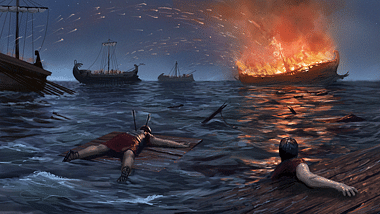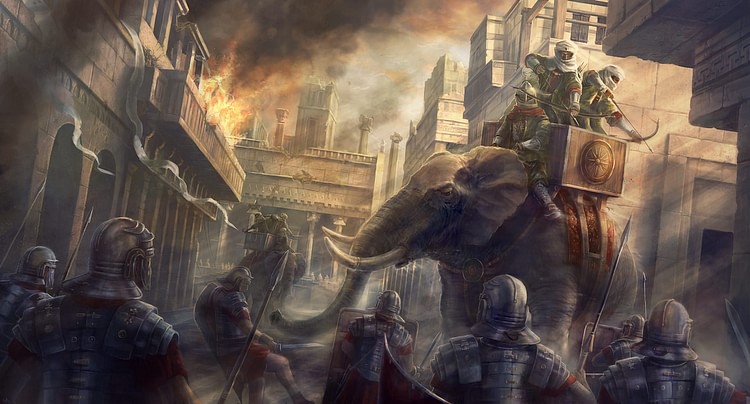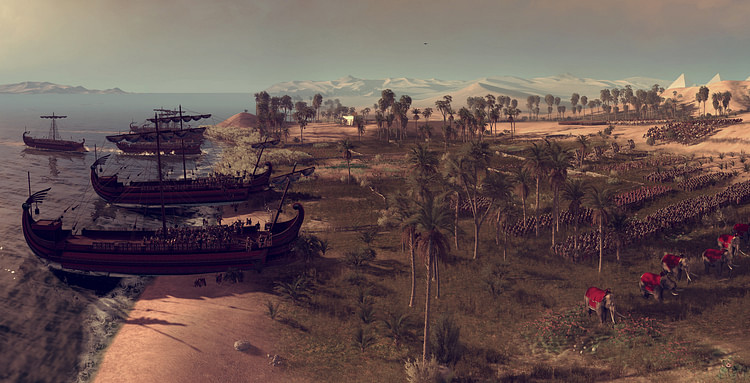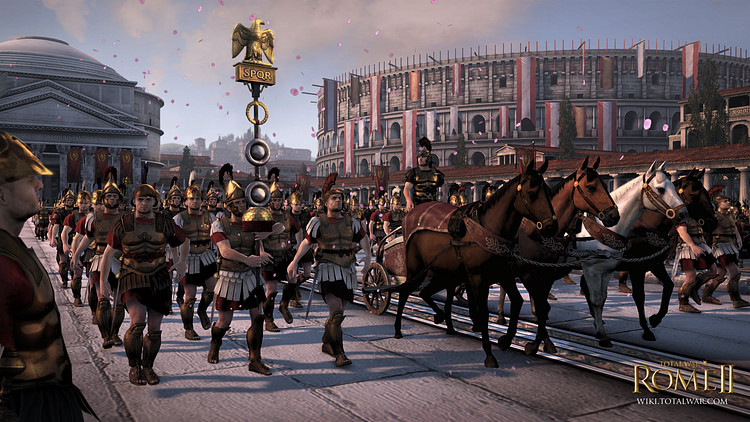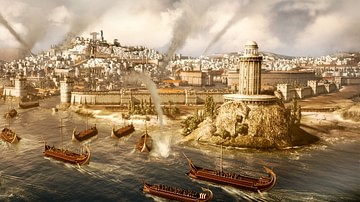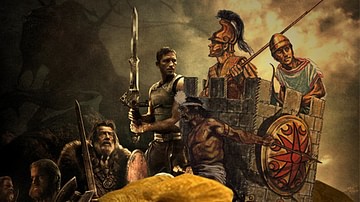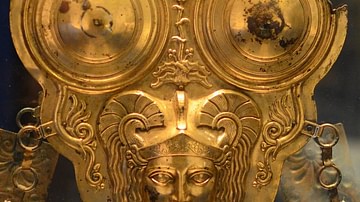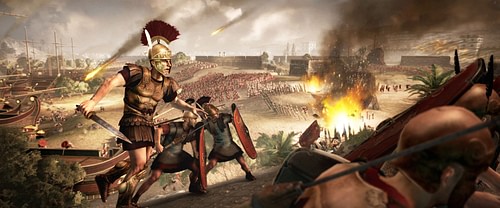
The First Punic War (264-241 BCE) was fought between Carthage and Rome largely over control of Sicily. The war was fought on the island, at sea, and in north Africa. Both sides enjoyed victories and suffered near-catastrophic defeats. The Romans, with seemingly inexhaustible resources, adapted to the necessities of naval warfare and eventually won.
After the war, the longest continuous conflict up to that time in history, Sicily became the first foreign Roman province. Carthage was not finished, though, and once it had sorted out its internal problems and gained new finances the conflict would resume with the Second Punic War within a generation.
Causes of the War
Relations between the two powers had largely been peaceful for centuries before the war. Peace treaties were signed in 509 BCE, 348 BCE, 306 BCE, and 279 BCE, which outlined each empire's sphere of influence, but when Rome became more ambitious in Magna Graecia, Carthage sought to defend its interests. The particular bone of contention was Sicily, a strategically important and prosperous island that the Carthaginians had long disputed with Greek city-states and which now also attracted the attentions of Rome. When Rome took control of Rhegium and Messana sought Roman protection from the double threat of Carthage and Hieron II (tyrant of Syracuse), relations soured further between the two great powers of the Mediterranean, both wary, suspicious, and eager to outdo the other.
Messana had been conquered by the Mamertines, a group of disreputable mercenaries from Campania in Italy, in 288 BCE. Losing a battle with Hieron II c. 265 BCE, they first looked to the Carthaginians for help who obliged by establishing a garrison in the city. The Mamertines also saw Rome as a powerful ally who could guarantee their independence, and when their help was offered, they removed the Carthaginian garrison. Rome sent the consul Appius Claudius Caudex and two legions to Sicily while Carthage responded by first crucifying the garrison commander who had been kicked out of Messana and then forming an alliance with both Acragas (Agrigento) and Syracuse. On arrival, the Carthaginian fleet joined forces with Hieron, besieged Messana, and waited to intercept the Roman landing by Appius Claudius. Hanno, the Carthaginian commander, warned the Romans that his fleet would ensure the Romans would not even be able to wash their hands in the sea. Faced with this dramatic response from Carthage, the Roman consul, now at Messana, offered a peace deal, but it was rejected by the Carthaginian commander Hanno.
The Roman ships and 16,000 troops of Claudius could not be stopped, though, and, at the second attempt, they reached Messana overnight to break the siege on the city, defeating both the Carthaginian and Syracusan armies. A new Roman commander, consul Manius Valerius Maximus Messalla, took over from Claudius and attacked Syracuse itself. Hieron surrendered before the Carthaginian fleet could offer help and, on agreeing to become Rome's ally, was allowed to remain in power. Losing its ally did not deter Carthage and, probably encouraged by the withdrawal of half the Roman forces back to Italy, sent another army to Sicily in 262 BCE. The First Punic War was underway.
Opening Engagements – Roman Victories
The Romans besieged Acragas with four legions led by both consuls L. Postumius Megellus and Q. Mamilius Vitulus in 262 BCE, and when the Carthaginians tried to defend their ally, they were defeated and the city sacked. The harsh treatment of Acragas revealed to the Sicilian city-states what Rome was capable of. Segesta was another loss to Carthage, the city deciding to join the Roman cause in 263 BCE. Small-scale engagements then occurred without any decisive outcome, and Acragas was sacked for a second time with 50,000 of its inhabitants enslaved. However, it was clear by 261 BCE that if Rome wanted to defeat Carthage, prevent continual reinforcement of the enemy by sea, and control all of Sicily, it would need a naval force capable of the job.
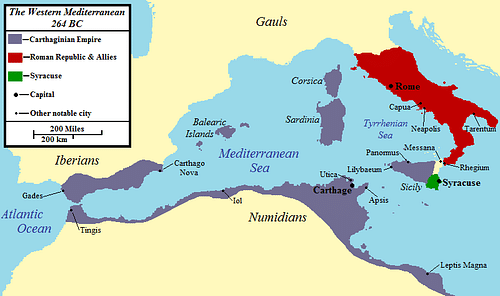
In the spring of 260 BCE, Rome had managed to build itself in only 60 days a fleet of 20 triremes and 100 quinquereme warships which had three banks of rowers organised into groups of five. Not having any great experience of naval warfare at this point, the Romans probably copied the Carthaginian vessels they had managed to capture earlier in the war and the rowers trained on special benches on land while the ships were constructed.
As in many other areas of technology the Romans added innovations to existing designs. In this case, they added the corvus (raven), a rotating platform with a giant holding spike (like a beak, hence the bird name). This bridge was 11 metres long and could be lowered onto an enemy vessel to allow a heavy infantry unit (perhaps 80-120 men) to board them. The idea would negate the superior seamanship of the Carthaginians and make naval combat more like a land battle, which the Romans were more familiar with. The invention was a success and brought the Romans immediate victory when their fleet of 145 ships, commanded by Duilius, defeated the Carthaginian fleet of 130 ships at the battle of Mylae (Milazzo) in 260 BCE. Duilius was honoured with a Roman triumph, the first in Rome's history to be awarded for a naval victory.
Following two years of stalemate in which the Romans contented themselves with raids on Corsica and Sardinia, they won another naval battle at Sulcis in 258 BCE. The Carthaginians crucified their commander as a result of the defeat. Then, in 256 BCE, a large Roman fleet (of 330 ships according to Polybius) won another important victory, at the battle of Ecnomus (Licata). The Carthaginians seemed to have no answer to the corvus boarding tactic. The consul Marcus Regulus Atilius then landed with an army of four legions at Clupea, also known as Aspis (in modern Tunisia). The war was now expanding to Carthaginian soil.
Carthage Fights Back
Once in Africa and somewhat inexplicably, the Romans chose this moment to recall half the army and the fleet, but this over-confidence still left Regulus some 15,000 infantry and 500 cavalry at his disposal. The Roman Senate may have thought an attack on Carthage would have to wait until the approaching winter was over and so withdrew two legions to Italy. In any case, Regulus won a comprehensive land battle south of Tunis where the Carthaginians, with no fewer than three commanders, were not helped by the rough terrain which made use of their elephants impossible. Regulus occupied the city and in 255 BCE peace talks followed between the two sides but collapsed under the Roman commander's excessive demands which included Carthage giving up Sicily altogether.
Carthaginian fortunes improved when their mercenary Spartan commander Xanthippus reorganised the army and, with 12,000 infantry and 4,000 cavalry, prepared to face the Romans. Xanthippus brilliantly combined his cavalry and 100 war-elephants, totally defeating the enemy and capturing the Roman general in the process. 12,000 Romans were killed against 800 Carthaginians. The remains of Regulus' army (a mere 2,000 men) managed to flee and were picked up by a newly dispatched fleet at Clupea, but most of these ships were then destroyed in a storm drowning as many as 100,000 men. Polybius described it as the greatest naval disaster in history. Perhaps if the Romans had not withdrawn half their number and made better use of the local Libyan uprisings at Carthage, the war might have ended in 255 BCE. Instead, there were still 14 more years to go in what was proving to be a brutal and exhausting conflict.
The War Returns to Sicily
Having failed to capitalise on their early success in Africa, the Romans returned to familiar ground in Sicily in 254 BCE when they captured Panormus (Palermo). Of the 70,000 population, those who could pay 200 drachmas were given their freedom, the rest were enslaved. The Carthaginians, in the meantime, sacked and razed Acragas but were now left with only a narrow coastal strip in their control. Once again, though, the elements conspired against the Romans when a storm destroyed 150 ships of the fleet of C. Sempronius Blaesus while he was returning from another raid on North Africa. Again thousands of men drowned and it may be that the corvus was in part to blame for its added weight to the ships in bad weather may have been a factor in the sinking of so many vessels. The corvus could, of course, have been dismantled and stowed for voyages, but it is interesting to note that the device is not mentioned again after this disaster.
Following a period when Carthage had to concentrate on affairs closer to home and ensure its control of its African territories, the city's ambitions once more stretched to Sicily, and another army was sent to the island in 251 BCE. The expedition, led by Hasdrubal, was another failure, though, and the army was defeated near Panormus by two legions commanded by the consul Lucius Caecilius Metellus in June 250 BCE. Caecilius even captured the Carthaginian's elephants, which had, in fact, caused more trouble to the Carthaginian infantry than they had to the enemy, and shipped them back to Rome to entertain the populace during his triumph. Regulus (back again) and fellow consul L. Manius Vulso then proceeded to lay a lengthy, and ultimately unsuccessful, siege of Lilybaeum (Marsala). The city and the other Carthaginian fortress cities were proving impossible nuts to crack.
The War Drags on – Hamilcar Commands
Just as Carthage kept losing on land and the Romans suffered losses at sea, so the trend continued in 249 BCE when the Carthaginian fleet, led by Adherbal, defeated the Roman fleet at Drepana (Trapani) capturing 93 of the 120 enemy ships. The Romans had been led by the unpopular consul of 249 BCE, P. Claudius Pulcher, he who famously threw his sacred chickens into the sea after they refused to provide the good omen of eating prior to battle. The Romans would soon follow the route of the chickens when another large fleet, which included 800 supply ships, was sunk for a third time by a storm, this time in the Bay of Gela. This did not prevent the Romans from taking Eryx (Erice), but the war was now taking its toll on both sides and their finances were incapable of funding more armies until 247 BCE. Carthage had even resorted to asking Egyptian ruler Ptolemy II for 2,000 talents to help them fund the war effort. Unsurprisingly, he could not be persuaded to part with such a huge sum.
Then the enterprising Hamilcar Barca (father of Hannibal) came to the fore. He replaced Carthalo, who had not been altogether unsuccessful, as the commander of the Carthaginian fleet. Hamilcar first raided the Italian coast in 247 BCE, perhaps in search of booty to pay his mercenaries, and then landed on Sicily at Heircte near Panormus. This position allowed Hamilcar to harass the rear of the Roman forces who were besieging Drepana and Lilybaeum which were Carthage's last remaining strongholds on Sicily. Hamilcar stuck to lightning quick guerrilla tactics (hence his name Barca from the Punic Baraq meaning lightning) as Carthage no longer had the resources for a large army, but he did capture Eryx in 244 BCE which became his new base. The Carthaginian commander also continued to attack the Italian mainland, but without a significant force at his disposal his effect on the war was limited. Perhaps more useful for Carthage in the longer term were the campaigns of Hanno the Great in Libya who expanded Carthage's African empire and so increased the source of tax revenue needed to fund the outrageously expensive war.
Rome Victorious
242 BCE saw the Romans with a brand new 200-ship fleet, funded this time by loans from rich private citizens, under the command of consul Gaius Lutatius Catulus. He put it to good use and besieged, yet again, Drepana. On 10th March 241 BCE, the Romans defeated a Carthaginian fleet led by Hanno sent to relieve the besieged city off the Aegates Islands (Isole Egadi). 50 Carthaginian ships were sunk, 70 captured, and 10,000 prisoners taken. This loss was not huge but, after decades of war, it drove the cash-strapped Carthaginians to seek peace terms.
Carthage was made to withdraw from Sicily and had to pay Rome 3,200 talents of silver in reparations over the next decade. Sicily became Rome's first foreign province (provincia) and Corsica and Sardinia would soon fall under Roman control too. In the event, Rome largely ignored Sicily in the following decades, and the Carthaginians had to deal with revolts and wars from unpaid mercenaries in Libya. Within a generation, though, and this time led by their most gifted general Hannibal, the Carthaginians would concentrate on land warfare and return to attack Rome much closer to home in another epic conflict, the Second Punic War of 218 - 201 BCE.
